InFocus X2 User Manual
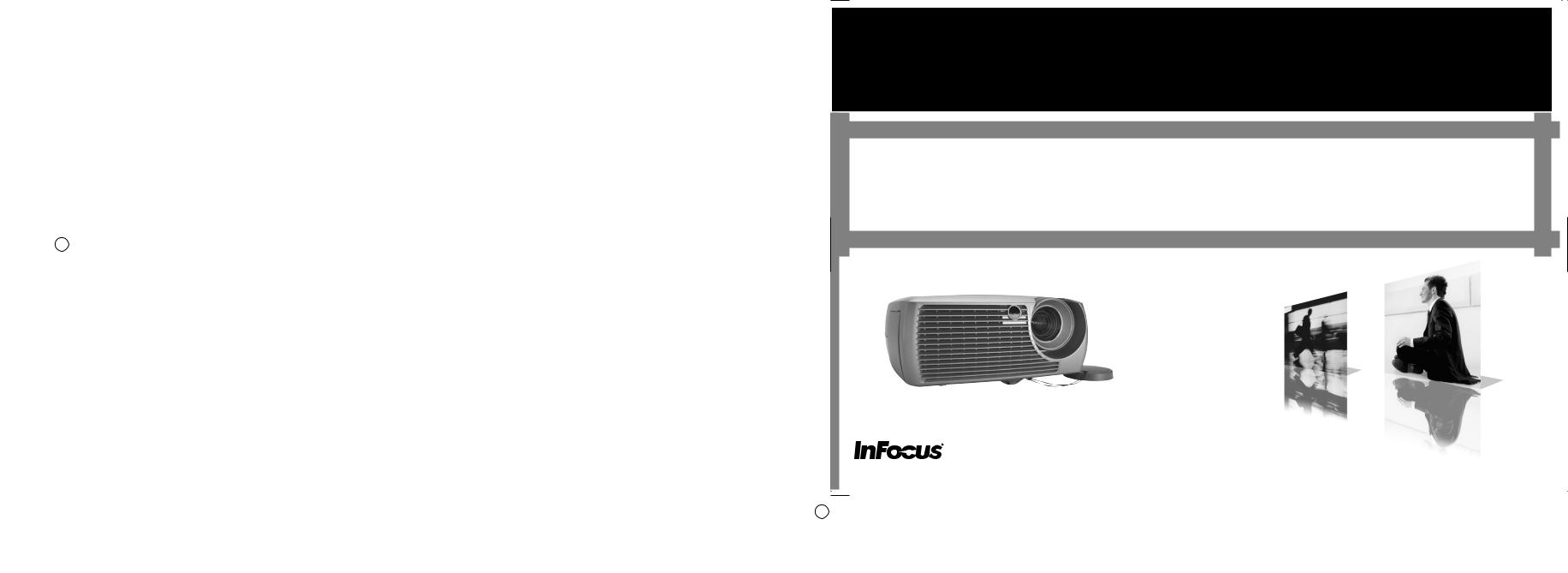
X2 MULTI-USE PERFORMANCE
USER’S GUIDE
Declaration of Conformity
Manufacturer: InFocus Corporation, 27700B SW Parkway Ave. Wilsonville, Oregon 97070 USA
European Office: Strawinskylaan 585, 1077 XX Amsterdam, The Netherlands
We declare under our sole responsibility that this projector conform to the following directives and norms:
EMC Directive 89/336/EEC, Amended by 93/68/EEC EMC: EN 55022
EN 55024 EN 61000-3-2 EN 61000-3-3
Low Voltage Directive 73/23/EEC, Amended by 93/68/EEC Safety: EN 60950: 2000
February, 2004
Trademarks
Apple, Macintosh, and PowerBook are trademarks or registered trademarks of Apple Computer, Inc. IBM is a trademark or registered trademark of International Business Machines, Inc. Microsoft, PowerPoint, and Windows are trademarks or registered trademarks of Microsoft Corporation. Adobe and Acrobat are trademarks or registered trademarks of Adobe Systems Incorporated. InFocus, ProjectorManager, ProjectorNet, LiteShow, and LP are trademarks or registered trademarks of InFocus Corporation.
This User’s Guide applies to model X2.
FCC Warning
Note: This equipment has been tested and found to comply with the limits for a Class B digital device, pursuant to part 15 of the FCC Rules. These limits are designed to provide reasonable protection against harmful interference in a residential installation. This equipment generates, uses and can radiate radio frequency energy and, if not installed and used in accordance with the instructions, may cause harmful interference to radio communications. However, there is no guarantee that interference will not occur in a particular installation. If this equipment does cause harmful interference to radio or television reception, which can be determined by turning the equipment off and on, the user is encouraged to try to correct the interference by one or more of the following measures:
--Reorient or relocate the receiving antenna.
--Increase the separation between the equipment and receiver.
--Connect the equipment into an outlet on a circuit different from that to which the receiver is connected.
--Consult the dealer or an experienced radio/TV technician for help.
Canada
This Class B digital apparatus complies with Canadian ICES-003.
Cet appareil numérique de la classe B est conforme à la norme NMB-003 du Canada.
Agency Approvals
UL, CUL, NOM, IRAM, GOST, C-tick
Other specific Country Approvals may apply. Please see product certification label.
InFocus reserves the right to alter product offerings and specifications at any time without notice.
2
Table of Contents
Introduction |
5 |
Positioning the projector |
7 |
Projector and Device Connector Guide |
8 |
Computer connections |
8 |
Video connections |
8 |
Connecting a computer source |
11 |
Required computer connections |
11 |
Optional computer connections |
11 |
Displaying a computer source image |
12 |
Adjusting the image |
13 |
Using the projector with Windows 98 for the first time |
14 |
Connecting a video device |
16 |
Video device connections |
17 |
Composite video connection |
17 |
S-video connection |
17 |
VGA connection |
18 |
Displaying video |
19 |
Adjusting the image |
19 |
Shutting down the projector |
21 |
Troubleshooting your setup |
21 |
Using the remote control |
29 |
Using the audio |
30 |
Using the keypad buttons |
31 |
Optimizing computer images |
32 |
Presentation features |
32 |
Optimizing video images |
33 |
Customizing the projector |
33 |
Using the menus |
34 |
Picture menu |
35 |
Settings menu |
38 |
Maintenance |
41 |
Cleaning the Lens |
41 |
Replacing the Projection Lamp |
41 |
Cleaning the Lamp Housing Screens |
43 |
Using the security lock |
43 |
Appendix |
44 |
Projected Image Size |
44 |
Red LED Behavior and Projector Errors |
44 |
If you are experienced in setting up projection systems, use the Quick Setup card that is included with the projector. For complete details on connecting and operating the projector, refer to this User’s Guide. Electronic versions of this User’s Guide in multiple languages are available on the included CD.
The most current versions can be found on our website.
The website also has technical specifications (an interactive image size calculator, laptop activation commands, connector pin outs, a glossary, the product data sheet), a web store to buy accessories, and a page for online registration.
3
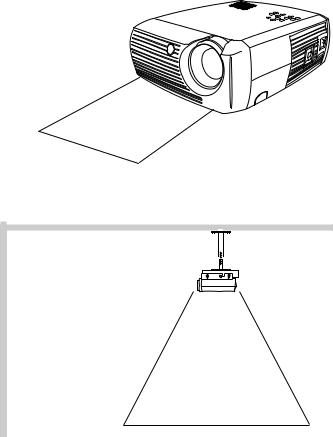
Important Operating Considerations for Safety
•Place the projector in a horizontal position no greater than 15 degrees off axis.
•Locate the projector in a well-ventilated area without any obstructions to intake or exhaust vents. Do not place the projector on a tablecloth or other soft covering that may block the vents.
•Locate the projector at least 4' (1.2 m) away from any heating or cooling vents.
•Use only InFocus-approved ceiling mounts.
•Use only the power cord provided. A surge-protected power strip is recommended.
•Refer to this manual for proper startup and shutdown procedures.
•In the unlikely event of the lamp rupturing, discard any edible items placed in the surrounding area and thoroughly clean the area along all sides of the projector. Wash hands after cleaning the area and handling the ruptured lamp. This product has a lamp which contains a very small amount of mercury. Dispose of it as required by local, state or federal ordinances and regulations. For more information see www.eiae.org.
Follow these instructions to help ensure image quality and lamp life over the life of the projector. Failure to follow these instructions may affect the warranty. For complete details of the warranty, see the Warranty section at the end of this User's Guide.
|
|
|
) |
|
|
m |
|
2 |
ft |
(.6 |
|
|
|
||
|
|
|
|
Do not place objects or people in the 2 foot (.6m) area along the front of the projector. For ceiling mount applications, this area should be 5 feet (1.5m).
5 ft (1.5m) |
4
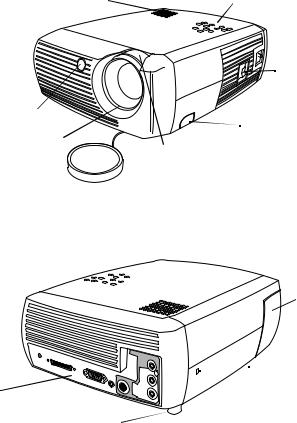
Introduction
Your new digital projector is simple to connect, easy to use, and straightforward to maintain. It is a versatile projector that is flexible enough for business presentations and home video viewing too. It has native SVGA 800x600 resolution and is compatible with a wide variety of computers and video devices, including:
•Most standard VCRs, DVD players (progressive and interlaced), progressive DVD, HDTV sources, TV and satellite tuners, camcorders, video games, and laser disc players.
•IBM-compatible computers, including laptops, up to 1024x768 resolution.
•Apple® Macintosh® and PowerBook® computers up to 1024x768 resolution.
Product specifications
To read the latest specifications on your multimedia projector, be sure to visit our website, as specifications are subject to change. Web address information is located on the back inside cover of this User’s Guide.
Accessories
The standard accessories that came with your projector can be found on the included packing list. Optional accessories are listed in the Accessories catalog that came with the projector and can also found on our website. See the inside back cover for the Web address.
Online Registration
Register your projector on our website to receive product updates, announcements, and registration incentives. See the inside back cover for the Web address.
remote control receiver (IR)
focus (thin ring)
speaker |
keypad |
power cord connector
power switch
adjustable foot release
zoom (thick ring)
 tethered lens cap
tethered lens cap
lamp housing door
 security lock
security lock
connector panel
adjustable foot
5
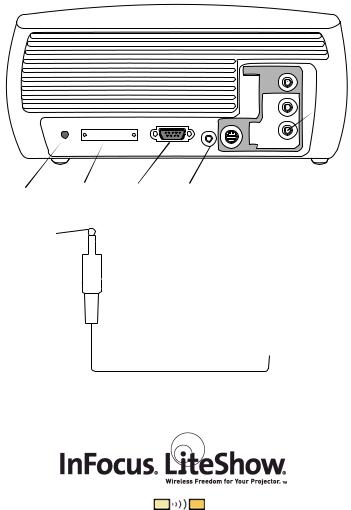
Connector Panel
The projector provides both computer and video connection options, including:
•M1 for computer and video
•S-video
•Composite RCA audio/video
The projector also provides the following connectors:
•Monitor out
•Audio out
•12 volt DC output (see below)
12 volt DC output
The 3.5mm mini-jack trigger provides a 12 volt DC output. It provides a constant output while the projector is on. It has numerous uses. For example, if you connect your projection screen to the 12 volt DC output with the cable that came with your screen, when you turn on the projector the screen will move down; when you turn the projector off, the screen will return to the storage position. To use the 12 volt DC output, you must first remove the safety plug and turn Screen Trigger on in the System menu (see
page 38).
Wireless Projection
You can use the projector’s M1 connector along with the InFocus LiteShow wireless adapter and software for cable-free digital projection.
Contact an authorized InFocus dealer or visit the website listed on the back inside cover of this User’s Guide for more information.
 RCA
RCA  audio/visual
audio/visual
12 volt |
|
|
|
|
|
|
|
|
|
|
|
|
|
M1computer monitor |
audio |
|
|
||||||||||
|
|
||||||||||||
S-video |
|||||||||||||
DC output |
|
|
|
|
|
|
|
|
|
|
out |
|
|
+12v |
|
|
|
|
|
|
|
ground |
|
|
|
||
|
|
|
|
|
|
|
|
12 volt DC output |
|||||
|
|
|
|
|
|
|
|
||||||
|
|
|
|
|
|
|
|
|
3.5mm plug |
||||
|
|
|
|
|
|
|
|
|
|||||
|
|
|
|
|
|
|
|
|
|||||
|
|
|
|
|
|
|
|
|
|
|
|
|
|
|
|
|
|
|
|
|
|
|
|
|
|
|
|
|
|
|
|
|
|
|
|
|
|
|
|
|
|
|
|
|
|
|
|
|
|
|
|
|
|
|
|
|
|
|
|
|
|
|
|
|
|
|
|
|
|
to, for example, screen relay (see screen manufacturer for details)
6
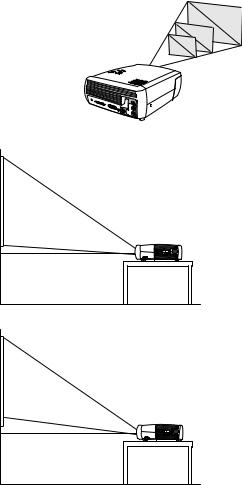
Positioning the projector
To determine where to position the projector, consider the size and shape of your screen, the location of your power outlets, and the distance between the projector and the rest of your equipment. Here are some general guidelines:
•Position the projector on a flat surface at a right angle to the screen. The projector must be at least 4.9 feet (1.49m) from the projection screen.
•Position the projector within 10 feet (3m) of your power source and within 6 feet (1.8m) of your video device (unless you purchase extension cables). To ensure adequate cable access, do not place the projector within 6 inches (.15m) of a wall or other object.
•If you are installing the projector on the ceiling, refer to the installation guide that comes with the Ceiling Mount Kit for more information. To turn the image upside down, see “Ceiling” on page 38. We recommend using an authorized ceiling mount.
•Position the projector the desired distance from the screen. The distance from the lens of the projector to the screen, the zoom setting, and the video format determine the size of the projected image. The top illustration to the right shows three projected image sizes. For more information about image sizes at different distances, see “Projected Image Size” on page 44.
•The image exits the projector at a given angle. This image offset is 112.2% when the projector is in 4:3 mode (default mode). This means that if you have an image 10’ high, the bottom of the image will be 1.22’ above the center of the lens.
•This image offset is 132.9% when the projector is in 16:9 mode. This means that if you have an image 10’ high, the bottom of the image will be 3.29’ above the center of the lens.
•See “Connecting a video device” on page 16 for additional information on 16:9 and 4:3 modes.
|
1 |
|
|
2 |
|
|
. |
|
|
5 |
|
|
f |
|
|
t |
|
5 |
. |
|
f |
|
|
t |
|
|
3 . |
|
|
. |
|
|
3 |
|
|
f |
|
|
t |
|
|
. |
|
19 ft. |
|
|
|
7.5 ft.
4.8 ft.
10 ft high image
Projection angle in 4:3 mode (default)
bottom of image |
|
1.22 ft above center |
lens center |
of lens |
|
10 ft high image
bottom of image 3.29 ft above center
of lens
Projection angle in 16:9 mode |
lens center |
7

Projector and Device Connector Guide
The following illustration and table should help you find the connectors to use and obtain the best resolution possible from your input devices, such as computers, standard VCRs, DVD players (progressive and interlaced), HDTV sources (1080i, 1035i, and 720p HDTV formats), TV and satellite tuners, camcorders, video games (progressive and interlaced), and laser disc players.
Computer connections
Computer connections involve attaching the VGA and USB ends of the provided computer cable to a computer and connecting the other end (M1) to the Computer In input on the projector. The USB part of the computer cable allows you to advance slides in a PowerPoint™ presentation via a remote control. See page 11 for computer/projector setup information.
Video connections
The first step for connecting video is deciding what type of output connector you want to connect to the projector. If there is more than one output on your video device, select the one with the highest quality. Your options are S-video (higher quality) and Composite video (lesser quality).
If you are connecting the projector to HDTV sources, the projector’s M1 computer connector, labeled Computer In, should be used. Keep in mind that HDTV and progressive sources should only be handled through the projector’s computer connector. You can also use an M1 to Component adapter (available as an optional accessory) to connect a progressive source’s component connectors to the projector. The S-video port does not function with progressive sources.
projector input connectors |
|
|
audio/visual |
|
|
|
(composite) |
||
12 volt |
computer in |
monitor |
S-video |
|
(HDTV and |
||||
DC output |
(out) |
audio out |
||
progressive |
||||
|
|
|
sources)
8
|
|
|
Attach to Adapter |
|
|
|
|
|
|
|
|
||
Video Device |
Video |
If Your Device |
or Labeled |
For Setup Instructions, see |
Comments |
|
Compatibility |
Connector Is |
Connector on |
||||
|
|
|
||||
|
|
|
Projector |
|
|
|
|
|
|
|
|
|
|
Standard Broadcast TV (not |
NTSC, PAL, and |
Composite video |
Composite video |
Composite video connection on |
Not for progressive |
|
HDTV) via: cable, digital |
SECAM formats |
or S-video |
or S-video |
page 17. |
(i.e. HDTV) sources. |
|
cable, satellite TV, DVD, or |
|
|
|
|
See page 10. |
|
VCR |
|
|
|
S-video connection on page 17 |
|
|
|
|
|
|
|
|
|
|
NTSC, PAL, and |
Composite video |
Composite video |
Composite video connection on |
Not for progressive |
|
Standard Video Camera |
SECAM formats |
or S-video |
or S-video |
page 17. |
(i.e. HDTV) sources. |
|
|
|
|
|
See page 10. |
||
|
|
|
|
|
||
|
|
|
|
S-video connection on page 17 |
|
|
|
|
|
|
|
|
|
|
NTSC, PAL, and |
Composite video |
Composite video |
Composite video connection on |
Not for progressive |
|
Standard Video Game |
SECAM formats |
or S-video |
or S-video |
page 17. |
(i.e. HDTV) sources. |
|
|
|
|
|
See page 10. |
||
|
|
|
|
|
||
|
|
|
|
S-video connection on page 17 |
|
|
|
|
|
|
|
|
9
|
|
|
Attach to Adapter |
|
|
|
|
|
|
|
|
||
Video Device |
Video |
If Your Device |
or Labeled |
For Setup Instructions, see |
Comments |
|
Compatibility |
Connector Is |
Connector on |
||||
|
|
|
||||
|
|
|
Projector |
|
|
|
|
|
|
|
|
|
|
|
1080i, 720p |
VGA |
Computer In |
VGA connection on page 18 |
Not for Component |
|
HDTV |
|
|
|
|
480i. |
|
(High Definition TV) |
|
Component video |
Computer In via |
M1 to Component adapter on |
|
|
|
|
|
optional M1 to Com- |
page 18 |
|
|
|
|
|
ponent adapter |
|
|
|
|
|
|
|
|
|
|
|
1080i, 720p |
VGA |
Computer In |
VGA connection on page 18 |
Not for Component |
|
|
|
|
|
|
480i. |
|
Progressive DVD |
Component 480p |
Component video |
Computer In via |
M1 to Component adapter on |
|
|
|
|
|
optional M1 to Com- |
page 18 |
|
|
|
|
|
ponent adapter |
|
|
|
|
|
|
|
|
|
|
|
1080i, 720p |
VGA |
Computer In |
VGA connection on page 18 |
Not for Component |
|
|
|
|
|
|
480i. |
|
Progressive Video Game |
Component 480p |
Component video |
Computer In via |
M1 to Component adapter on |
|
|
|
|
|
optional M1 to Com- |
page 18 |
|
|
|
|
|
ponent adapter |
|
|
|
|
|
|
|
|
|
10

Connecting a computer source
Required computer connections
Connect one end of the provided computer cable (see page 16 for connecting video devices) to the blue M1 Computer In connector on the projector. Connect the other ends (USB and VESA) to the USB and VGA ports on your computer. If you are using a desktop computer, you will need to disconnect the monitor cable from the computer’s video port first.
This connection allows you to advance slides in a PowerPoint presentation using the remote. USB drivers must be installed to use the USB feature. For more information, see page 15.
Connect the black power cord to the Power connector on the side of the projector and to your electrical outlet.
NOTE: Always use the power cord that shipped with the projector.
Optional computer connections
To have sound with your presentation, connect an audio cable (not included) to your computer and to the red and/or white Audio In connectors on the projector.
If you are using a desktop computer and want to see the image on your computer screen as well as on the projection screen, connect the computer’s monitor cable to the Monitor Out connector on the projector.
connect computer cable
connect power cable
connect audio cable
connect monitor cable
11
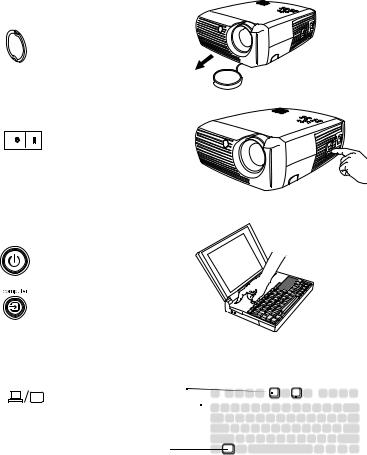
Displaying a computer source image
Remove the lens cap.
Toggle the Power switch on the side of the projector to the On position.
The LED flashes green and the fans start to run. When the lamp comes on, the start up screen displays and the LED is steady green. It can take a minute for the image to achieve full brightness.
? No start up screen? Get help on page 21.
remove lens cap
toggle Power switch
Turn on your computer.
The computer’s image should appear on the projection screen. If it doesn’t, press the Computer button on the projector’s keypad.
If your computer has Windows 98 as its operating system, see “Using the projector with Windows 98 for the first time” on page 14 regarding the driver setup process.
Make sure your laptop’s external video port is active.
Many laptops do not automatically turn on their external video port when a projector is connected. Usually a key combination like FN + F8 or CRT/LCD key turns the external display on and off. Locate a function key labeled CRT/LCD or a function key with a monitor symbol. Press FN and the labeled function key simultaneously. Refer to your laptop’s documentation to learn your laptop’s key combination.
? No laptop image? Try pressing the Auto Image button on the keypad. Get help on page 22.
turn on computer
activate laptop’s external port
monitor key
or LCD/CRT key
FN key
12
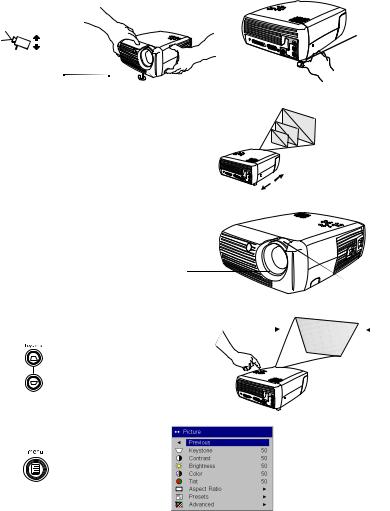
Adjusting the image
If necessary, adjust the height of the projector by pressing the release button to extend the foot.
If necessary, rotate the leveling foot located at the rear of the projector.
Avoid placing your hands near the hot exhaust vent in front of the projector.
Position the projector the desired distance from the screen at a 90 degree angle to the screen.
See page 44 for a table listing screen sizes and distances.
Adjust the zoom or focus.
If the image is not square, adjust the keystone using the buttons on the keypad.
Press the top Keystone button to reduce the upper part of the image, and press the bottom Keystone button to reduce the lower part.
Adjust the Contrast or Brightness in the Picture menu.
See page 35 for help with these menu adjustments.
adjust height |
rotate |
leveling foot
elevator |
|
foot |
release button |
adjust distance |
|
adjust zoom or focus
focus
(thin ring) zoom (thick ring)
adjust keystone
adjust Picture menu
13

Using the projector with Windows 98 for the first time
The first time you connect a computer running Windows 98 to the projector, the computer recognizes the projector as “new hardware” and the Add New Hardware Wizard appears. Follow these instructions to use the Wizard to load the correct driver (which was installed with your Windows operating system).
If you are running Windows 2000 or Windows ME, skip these steps and go to “Adjusting the image” on page 13.
aClick Next to begin searching for the driver.
bMake sure “Search for the best driver” is selected, then click Next.
cUncheck any checked boxes, then click Next. Windows automatically locates the driver. If this driver has been removed, reload the driver using your Windows operating system CD.
d When Windows finds the driver, you are ready to install it. Click Next.
a
b
c
d
14
Skip this page if you did not connect a USB mouse cable
For Windows 98:
•If you connected the USB cable, the Add New Hardware Wizard appears again. Drivers must be installed to use the USB functionality.
•The Wizard launches three times.
The first time it detects a USB Composite Device.
The second time a USB Human Interface Device (for the keyboard).
The third time it detects a USB Human Interface Device (for the mouse).
For Windows 2000, Windows ME, and Windows XP:
•The USB drivers are automatically installed.
15
